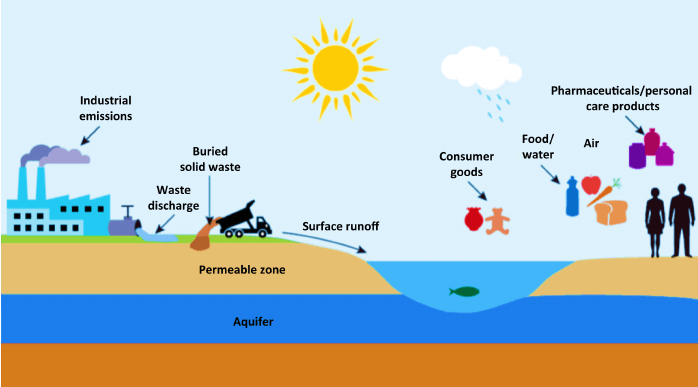One route by which exposure to hazardous and toxic materials may occur is the oral route. Hazardous materials may enter the body as a result of handling materials prior to eating or smoking. It is possible that hazardous materials may be ingested in large amounts accidentally; however, this is of minor concern in considering the working environment.
As parents are aware, this route becomes very important when considering the exposure of small~ inquisitive children to hazardous materials. In general, absorption in the system through the oral route is low. The major danger is the corrosive action to the gastrointestinal tract. The low absorption of materials ingested through the oral route is a result of the protection offered by the poor permeability of the gastrointestinal lining to many hazardous substances.
The major area of concern for the industrial hygiene engineer is with those toxic materials that may enter the body through the respiratory tract. Much of the industrial hygiene engineer’s work involves determining the concentration of hazardous pollutants that exist in the air of the work environment. This emphasis of concern is justified both in terms of the hazardous effect of respirable toxic substances on the human system and the ubiquitous nature of toxic substances that become suspended in the air.
The dos~ rate for respirable toxic materials substances are difficult to determine. The respiration rate and depth between individuals varies. This is particularly the case when, in a given work place, some individuals remain sedentary, and others are required to do more physical labor, thus increasing the respiration rate and depth. In addition, the concentration of pollutants in the air may vary at different locations of the work environment. Concentrations can also build up and reach peaks based upon production cycles that occur in the work environment. The variance in concentration as a result of location and time make the measurement of the pollutant difficult.
Certain protective mechanisms in the respiratory system provide a first line of defense against toxic materials that may be inspired. Soluble gases are absorbed in the moist mucous membrane of the upper respiratory tract, thus limiting their effect to that of an irritant in this area of the respiratory system. Particulate matter is filtered out of the respiratory system at various stages. The nasal structure and turbulent air flow that results cause the settling of large particles that are then captured by the mucous membrane of the nose.
The cilia, small hair-like filaments in the nose and upper respiratory tract, help the mucus filter particulate matter from incoming air. The large numbers of branches that occur in the bronchi also act to filter out large particulate matter. Usually, only the smallest particles will reach the alveoli of the lung. These particles are of a diameter of less than 10 micrometers. Once these particles have reached the lowest level of the lungs, phagocyte cell is (macrophages) entrap the particles to slow their potential harmful action in the body. Some particles are filtered out of the system through the lymph that circulates in the lymphatic system.
The most common route of exposure that exists in the industrial environment is the action of toxic substances on the skin. Substances coming in contact with the skin may react with the skin, causing dermatitis in the worker, or the material may be absorbed through the skin into the human system. Though dermatitis is unsightly, it is not nearly as severe as the harmful effects that can occur through respiration of toxic material. Only very toxic materials that are systemic in nature are 1ikely to cause harm by absorption through the skin.
The skin has certain protective mechanisms that inhibit exposure to toxic material through this route. The first mechanism is the multiple layers of skin that provide a less permeable surface. Perspiration from the sweat glands will dilute toxic substances that come in contact with the skin. The lipid fi 1m left on the skin surface as a result of the action of the sebaceous glands also provides a protective layer that must be penetrated. A breakdown of any of these protective mechanisms will cause a more serious hazard exposure to exist. Thus, if the oily fi 1m is removed by cutting oils, or if a break in the skin occurs through a wound, the danger to the worker of exposure through the coetaneous route is much higher.
Another route of entry for toxic materials into the body route is through the eyes. In a toxic environment, the eyes are subjected to splashing of toxic material. In addition, mists, vapors, or gases will also act upon the eyes. The first protective mechanism available to prevent harm to the eyes is the eyelids, which can be closed to prevent damage to the eyes. The second line of defense is the lachrymal action of the tear ducts, which act to dilute or wash away any harmful substances. In general, any damaging effects from ocular exposure to a hazardous material are limited to the area of the eye.
By: Shahana Raza







